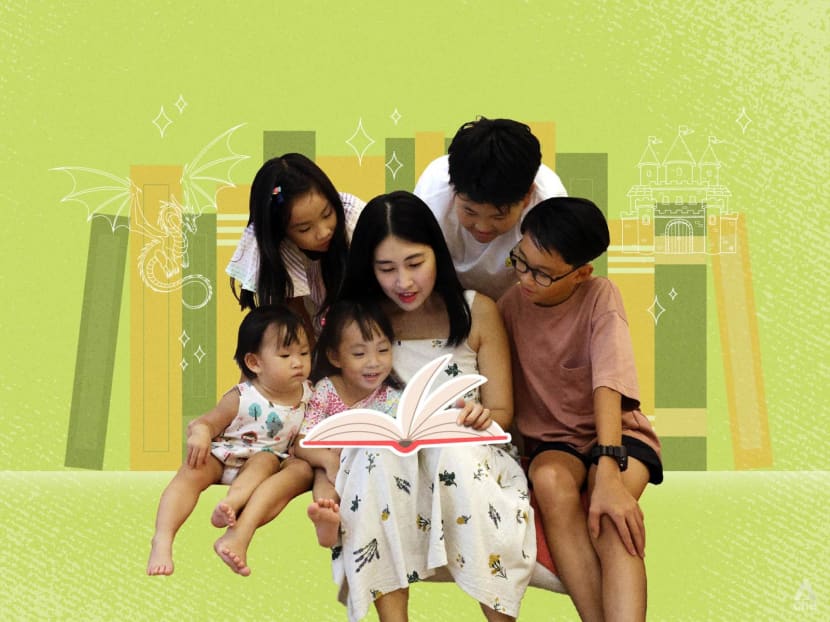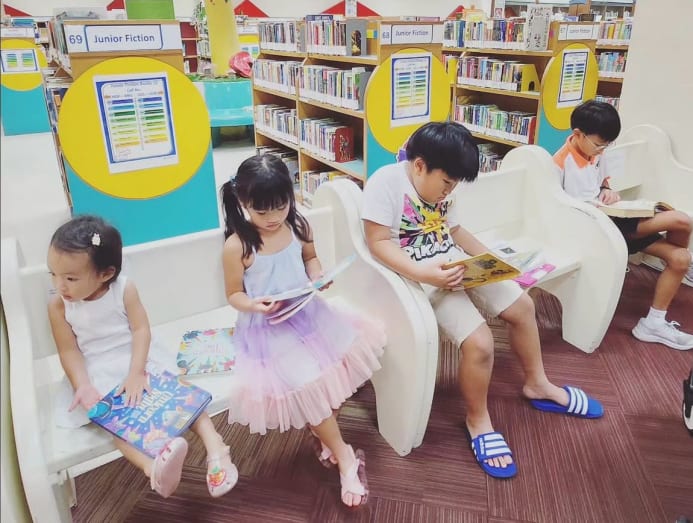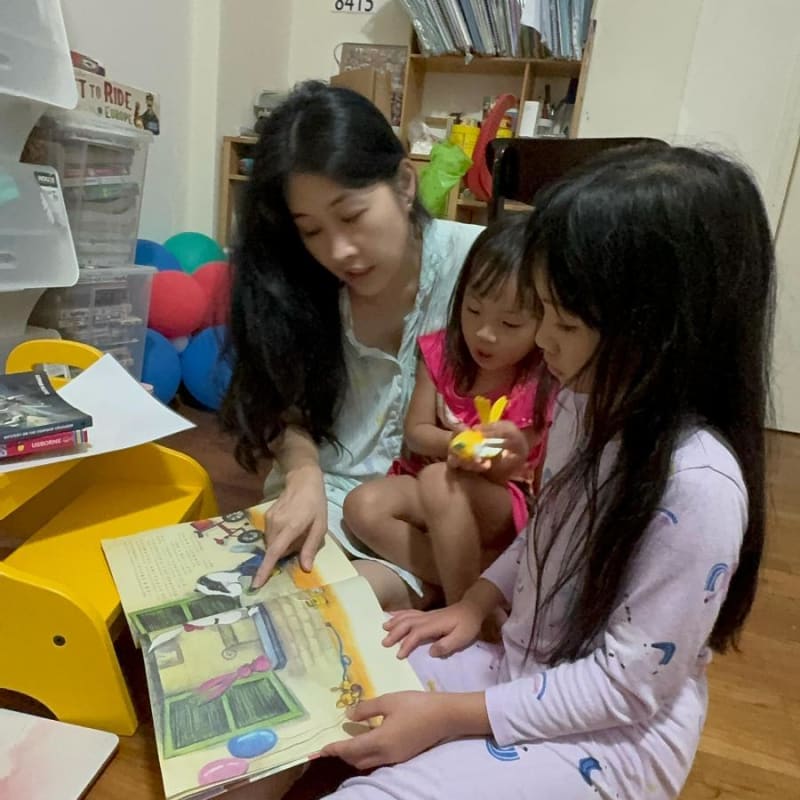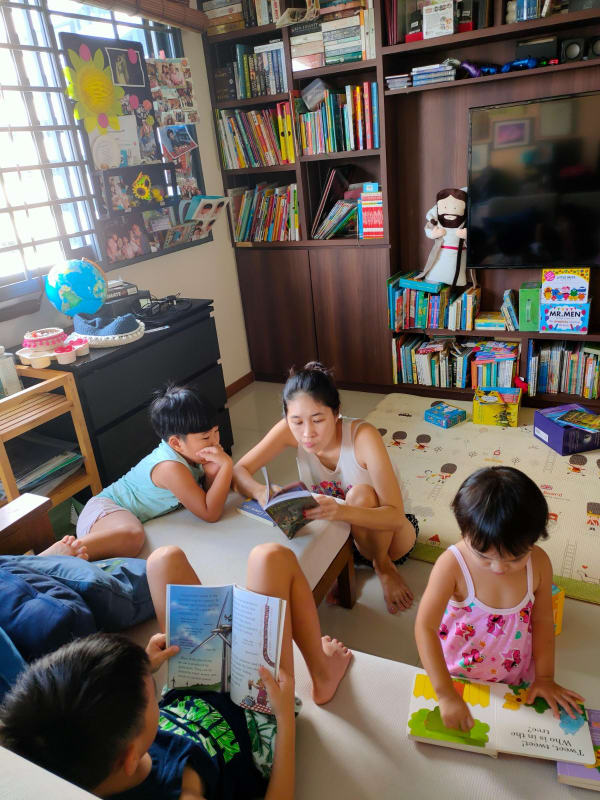As a child, I loved reading. As a parent, here’s how I’m teaching my kids to love it too
In Ms Kelly Ang’s household, books are the default mode of entertainment for her and her five kids. She shares how reading has become part of her family culture.

For Ms Kelly Ang (centre), her children are now enthusiastic bookworms, but it took a lot of hard work to get them there. (Illustration: CNA/Nurjannah Suhaimi)

This audio is generated by an AI tool.
As a kid, my favourite place in the world was my neighbourhood library.
From there, I travelled the globe and other universes. I went back in time to the Crusades and far into the future on spaceships bound for other stars. I befriended ethereal creatures, fought vampires and escaped zombies – all through the pages of my books.
I read everything and anything in front of me, from brochures and menus to even the nutritional information on food packaging. Nothing was too boring for my hungry eyes.
My reading habit shaped my personality growing up and continues to influence the way I parent. My husband and I want our kids to not only read, but to enjoy it the way we did as children – and still do as adults.
The 2021 Progress in International Reading Literacy Study by the Ministry of Education found that Singapore students are the top readers in the world, but they are also deriving less enjoyment from reading over the years.
In the last decade, Singapore students who reported “enjoying reading a lot” fell from 60 per cent in 2011 to just 51 per cent in 2021.
In a world where endless streams of content are instantaneously available for our consumption 24/7, taking the time to read a book seems almost counter-intuitive.
There are no moving pictures or sounds to hold our attention. No “likes”, comments or shares for “interaction”. No exciting edits or effects.
Just words that you have to read, make sense of and picture in your head.
Nevertheless, we’ve worked hard to make reading the default medium of entertainment in our household, over and beyond smartphones, TVs and games.
Twelve years into our parenting journey, it’s time to check in and ask ourselves: Has it really been working?
EVERY CHILD READS DIFFERENTLY
To me, a key sign of success is my kids’ excitement for the library.
Each month, we lug home 20 to 40 books at a time, our bags straining and groaning under the weight of our hauls.
Bookstore outings are even bigger treats, because they know that they get to keep the books we buy.
These are often read at breakneck speed: My boys (among the oldest of my five kids) can finish a 300-page novel in two to three hours, while my oldest daughter, aged seven, breezes through 50 to 80 pages in 30 minutes.
However, it wasn’t always like this.

At the age of five, my eldest still hadn’t begun reading. As a year-end baby, he seemed to lag behind his classmates, many of whom were reading well by the start of kindergarten.
We were a little worried then, but we just kept practising sight words, verbalising phonics and reading simple books to him.
Halfway through his Kindergarten 2 year, something clicked and then there was no stopping him.
He gobbled up science fact books and encyclopaedias meant for children, as well as the colourful adventure series Geronimo Stilton.
My second son picked up reading more intuitively at the age of four-and-a-half. Our guess is that he’d soaked up a lot from our reading sessions with his big brother.
By age five, he was tearing through space encyclopaedias, gushing to us about Jupiter’s 95 moons and why Pluto was no longer considered a full-fledged planet.
By the time it came to our third child, we were significantly less stressed about her apparent lack of reading interest and progress, even when her sixth birthday neared. We trusted that her reading appetite would develop naturally.
One year on, out of all my kids, she has emerged as the one who reads the most widely.
My two boys tend to stick to their preferred genres. For my eldest, fast-paced adventure or mystery stories. And for my second son, fantasy tales of magic and dragons.
My daughter, however, enthusiastically dives into stories about princesses, animals, schoolkids, mermaids, whodunnits, fairy and folk tales and more. She happily jumps right into whatever new titles I pick out for her at the library.
However, as someone who prides herself on her literary taste, I’ve learnt not to take it personally when my kids occasionally reject the books I’ve picked out for them.
Instead, I find myself excited to discover even more about their shifting reading preferences as they get older.
MOTHER TONGUE READING: A DIFFERENT BEAST
I believe the benefits of reading extend to the mother tongue, which children take up as a subject in school.
Yet, this is something I’ve struggled with all my life. Now, my children share my struggle – the constant advice we hear from their teachers in charge of the Mother Tongue curriculum is to “read more books for enjoyment”.
This year, I’ve been spending more time trying to help my children get into Chinese comics, interactive e-books and audiobooks.

For a while, my boys really enjoyed reading the Plants Vs Zombies comics in Chinese. I recently found another sports graphic novel in Chinese that they like and am tracking down the rest of the series for them, before their fickle interest in books of this language fizzles out.
Also on my list is an abridged version of Romance of the Three Kingdoms – a request from my oldest son, because he is studying it in school now.
My daughter enjoys the e-books on her school’s Chinese reading platform, but particularly likes the audiobooks and finds it fun to record herself reading the parts out as well.
She also likes fairy tales, Barbie or My Little Pony stories in Chinese, curiously asking questions as I read these to her.
Ultimately, I’ve found that what works best is when we read together with our kids. I can’t expect them to read Chinese materials independently if they don’t see me doing it, too.
READING AS FAMILY CULTURE
To me, reading isn’t just entertainment. It’s a great way to teach kids and youths values and life lessons.
Our lives are constantly shifting as our children grow, but one thing we’ve always held fast to is that we will never rely on screens as the primary form of entertainment.
Sure, there’s a time and place for Netflix and YouTube and Nintendo Switch, but we’re trying to encourage our kids to avoid making these their first port of call.

At home, I try to fill the spaces with physical books (sometimes to my husband’s annoyance) as tangible and visible reminders to us all to pick up a book and read.
Before heading out, we always remind our kids to take along a book if they want an option to keep themselves entertained.
I spend quite a bit of time and energy on cultivating this reading habit of ours.
I’m constantly scanning new book releases for titles that may interest my children and making trips to the library and bookstore – no small feat for a busy parent of five.
I also try to read a few chapters of the new books we borrow, to get a sense of the writing style and also to scan for any potentially worrying or iffy content.
Admittedly, it’s a lot of work, but in my view, it’s definitely worth it.
Some of my kids’ books are so well-loved that they’ve lost their covers or are held together by copious amounts of tape and glue. It warms my heart to see these physical signs of my kids’ love for reading.
Now, whenever we see our children lounging on the sofa with their noses in a book, my husband and I like to make it a point to pick up our own books and settle in next to them.
When they look up to see us embarking on our own literary adventures alongside them, we share a smile before continuing on together.
Kelly Ang is a mother of five and a freelance writer.














